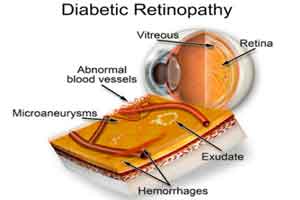- Home
- Editorial
- News
- Practice Guidelines
- Anesthesiology Guidelines
- Cancer Guidelines
- Cardiac Sciences Guidelines
- Critical Care Guidelines
- Dentistry Guidelines
- Dermatology Guidelines
- Diabetes and Endo Guidelines
- Diagnostics Guidelines
- ENT Guidelines
- Featured Practice Guidelines
- Gastroenterology Guidelines
- Geriatrics Guidelines
- Medicine Guidelines
- Nephrology Guidelines
- Neurosciences Guidelines
- Obs and Gynae Guidelines
- Ophthalmology Guidelines
- Orthopaedics Guidelines
- Paediatrics Guidelines
- Psychiatry Guidelines
- Pulmonology Guidelines
- Radiology Guidelines
- Surgery Guidelines
- Urology Guidelines
GLP-1 receptor agonist not associated with diabetic retinopathy

USA: An analysis of the U.S. Food and Drug Administration Adverse Event Reporting System (FAERS) database has revealed that glucagon-like peptide 1 receptor agonists (GLP-1RAs) do not appear to increase the risk for diabetic retinopathy (DR) in patients with type 2 diabetes.
Previous trials have suggested the association of GLP-1RAs semaglutide (approved late last year) and liraglutide with a higher incidence of DR adverse events, although the trials did not systematically look for this outcome.
Tiansheng Wang, the University of North Carolina at Chapel Hill, and colleagues examined the association of DR with GLP-1RAs as well as with other glucose-lowering drugs, glucose-lowering drugs excluding insulin, 2 classes of therapeutic alternatives (thiazolidinediones and SGLT2 inhibitors), SGLT2 inhibitors alone, and all other drugs in the database.
Also Read: Lipid lowering agents reduce incidence and progression of diabetic retinopathy
Dr. Wang's team examined the association of diabetic retinopathy with GLP-1RAs as well as with other glucose-lowering drugs, glucose-lowering drugs excluding insulin, 2 classes of therapeutic alternatives (thiazolidinediones and SGLT2 inhibitors), SGLT2 inhibitors alone, and all other drugs in the database.
Between April 2005 and September 2017, there were 389 diabetic retinopathy cases associated with the 4 GLP-1RAs included in the database (exenatide, liraglutide, albiglutide, and dulaglutide).
The odds for diabetic retinopathy were consistently lower with GLP-1RAs than with the other comparison groups, and there was no signal of increased diabetic retinopathy risk in analyses stratified by individual GLP-1RA.
Also Read: Low vitamin D increases diabetic retinopathy
"Unfortunately, in our study, there was no available semaglutide data," the researchers note, "(and) this database will not be ideal for future analysis because adverse event reporting is likely to be confounded by greater attention to the potential issue with semaglutide."
"Our analysis of the FAERS database indicates that there is no signal for the association between GLP-1RA and DR, which is consistent with the Exenatide Study of Cardiovascular Event Lowering (EXSCEL) and Liraglutide Effect and Action in Diabetes.

Disclaimer: This site is primarily intended for healthcare professionals. Any content/information on this website does not replace the advice of medical and/or health professionals and should not be construed as medical/diagnostic advice/endorsement or prescription. Use of this site is subject to our terms of use, privacy policy, advertisement policy. © 2020 Minerva Medical Treatment Pvt Ltd